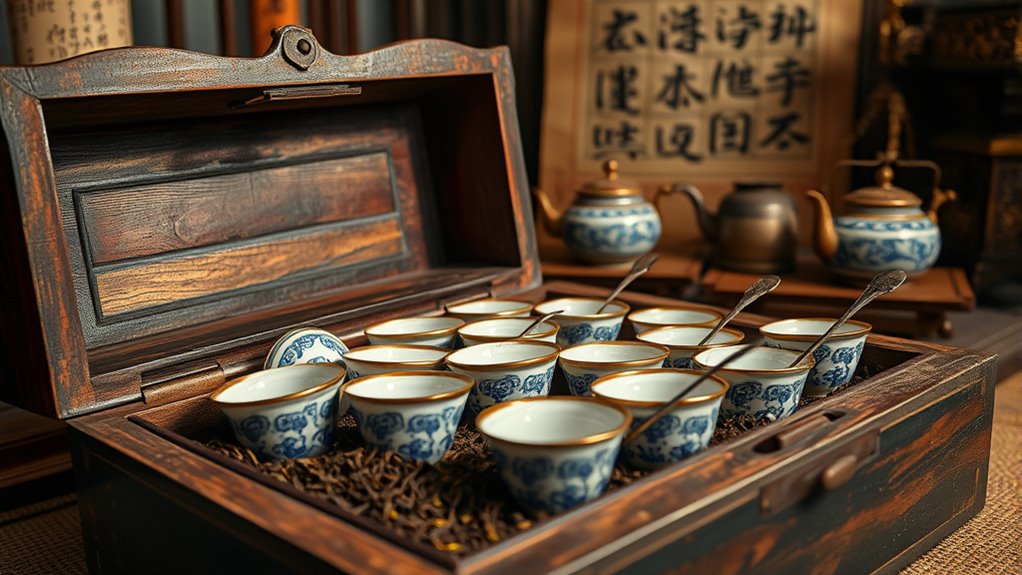Tea has a history that dates back thousands of years, starting in ancient China where legend credits Emperor Shen Nong with its discovery. It spread across Asia, becoming central to cultural and spiritual practices like Japan’s tea ceremony. When introduced to Europe, it became a symbol of elegance and social status. Throughout history, tea has also played key roles in political events, such as the Boston Tea Party. Exploring its rich traditions reveals how tea continues to connect people worldwide today.
Key Takeaways
- Tea originated in China around 2737 BCE, evolving into a vital cultural and spiritual practice over centuries.
- It spread across Asia, influencing rituals like Japan’s tea ceremony and Korea’s traditional preparation methods.
- Tea reached Europe, symbolizing refinement and social status, and contributed to the development of cafes and social gatherings.
- Significant historical events, such as the Boston Tea Party, highlight tea’s role in political resistance and social movements.
- Today, tea embodies hospitality, tradition, and innovation through diverse practices, from traditional ceremonies to modern infusions.

Have you ever wondered how a simple leaf became a global symbol of hospitality and tradition? It all started thousands of years ago in China, where legend credits Emperor Shen Nong with discovering tea around 2737 BCE. According to stories, a leaf from a nearby tea plant accidentally fell into his boiling water, creating an invigorating beverage that quickly gained popularity.
Over centuries, tea spread across Asia, evolving into a central part of cultural rituals, social gatherings, and even spiritual practices. You mightn’t realize it, but when you sip tea, you’re part of a long history that connects countless generations and civilizations.
Sipping tea links us to a rich, centuries-old global tradition of rituals, social bonds, and spiritual harmony.
As trade routes like the Silk Road opened, tea traveled beyond China’s borders, reaching Japan, Korea, and eventually Europe. In Japan, tea became an integral part of Zen Buddhism, leading to the development of the elegant tea ceremony, which emphasizes mindfulness and harmony. In Europe, tea gained popularity among aristocrats and the bourgeoisie, becoming a symbol of refinement and sophistication.
You can see its influence in the countless teahouses, cafes, and social rituals that developed over centuries. Each culture has adapted tea to its traditions, with unique preparation methods, ceremonies, and etiquette that reflect local values and aesthetics.
Throughout history, tea has also played a role in significant events. The Boston Tea Party in 1773, for example, marked a pivotal moment in American history, symbolizing resistance against colonial taxation and oppression. This event underscores how tea has been more than just a beverage; it’s intertwined with political and social movements.
On a more personal level, sharing tea often signifies hospitality, friendship, and respect. Offering someone a cup of tea can be a gesture of peace and goodwill, rooted deep in cultural norms that emphasize connection and community.
Additionally, the cultural heritage of tea is preserved through traditional practices and the dedication to maintaining authentic architectural styles found in historic tea houses and ceremonies around the world. Today, tea continues to evolve, blending tradition with innovation. From traditional loose-leaf brews to modern iced teas and herbal infusions, you have a vast array of choices that cater to taste, health, and lifestyle. Yet, despite the variety, the core idea remains the same: tea is a universal symbol of comfort and connection.
When you take a moment to enjoy a cup, you’re participating in a centuries-old tradition that spans continents and cultures. It’s a simple act, but one that carries a rich history, reminding you of the enduring power of a humble leaf to unite people across time and space.
Frequently Asked Questions
How Did Tea Influence Global Trade Routes Historically?
You see, tea revolutionized global trade routes by creating a demand that stretched across continents. As Europeans sought this prized beverage, they established new routes, like the famous tea trade from China to Europe.
This demand fueled exploration, colonization, and economic growth, connecting distant parts of the world. Tea’s popularity transformed trade networks, making it a key driver of international commerce and shaping the modern global economy.
What Are Rare Traditional Tea Preparation Methods Worldwide?
Imagine discovering secret rituals that transform simple leaves into treasured brews. You might encounter unique methods like the ancient Chinese Gongfu Cha, which involves precise pouring and multiple infusions, or the Japanese Kabusecha, where leaves are shaded before brewing.
In Tibet, butter tea blends tea with yak butter, creating a rich, energizing drink. These rare techniques reveal cultural stories, enriching your appreciation for tea’s diverse and fascinating traditions worldwide.
Which Cultures Have Unique Tea Ceremonies Not Widely Known?
You might find it fascinating that many cultures have unique tea ceremonies beyond the well-known ones. For example, in Japan, the Wagashi and Kaiseki rituals create a serene experience.
In Morocco, the elaborate process of pouring mint tea symbolizes hospitality.
In Tibet, yak butter tea offers a hearty tradition.
Exploring these customs reveals diverse ways people celebrate tea, highlighting its cultural significance across the globe.
How Has Tea Cultivation Impacted Local Economies Historically?
You see, tea cultivation has critically shaped local economies throughout history. When you look at regions like India, China, and Sri Lanka, you’ll notice how it created jobs, boosted trade, and supported infrastructure development.
Small farmers and large plantations alike benefited from demand, transforming rural areas into bustling centers of commerce. This growth often led to increased exports and foreign exchange earnings, making tea an essential economic driver for many communities worldwide.
What Are the Health Benefits Associated With Ancient Tea Varieties?
You’ll find that ancient tea varieties offer numerous health benefits. They’re rich in antioxidants, which help fight free radicals and reduce aging signs. Drinking these teas can boost your immune system and improve digestion.
Some varieties, like green or white tea, contain compounds that enhance mental alertness and relax your nerves. Incorporating ancient teas into your routine may support overall well-being, thanks to their natural nutrients and medicinal properties.
Conclusion
As you sip your tea today, it’s fascinating to realize that this simple beverage connects you to centuries of history and countless cultures. Who would’ve thought that a chance discovery in ancient China would weave itself into your daily routine? That fleeting moment of curiosity about tea’s origins now links you to a global tradition, reminding you that sometimes, the most ordinary things hold extraordinary stories—just like the cup in your hand.









